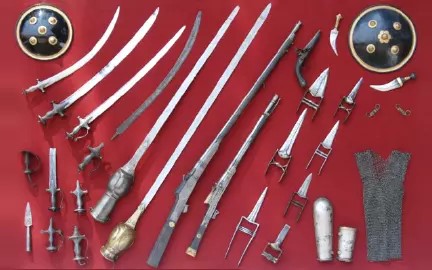



Ancient Indian armies employed a diverse arsenal, including swords and
daggers crucial for close combat. Sharply edged swords and deadly daggers enhanced a warrior’s effectiveness. Archery was also vital, serving as primary offensive weapons, enabling soldiers to adapt to varied combat situations.
Prominent among the ranged weaponry was the sarvatobhadra, a formidable machine designed to hurl stones in all directions, earning it the alternate name bhumirika yantra. Similarly, the bahumukha, a fortified tower on military installations, enabled archers to unleash arrows from multiple angles while being shielded by leather covers. The ingenuity of ancient Indian warfare extended to machines like the parjanynka, specifically designed to extinguish fires, showcasing the strategic foresight of military commanders.
Weapons were not restricted to swords and bows alone; the arsenal included axes of varying sizes, the spear and trident (trishul), the mace, javelins, and clubs. Unique weaponry such as the kunta, a long-handled spear, and the pasha, a sharp rod with needles, further exemplified the creativity embedded in weapon design. The chakra, with its distinct diagonal bars, symbolized divine power, often linked to revered deities.
The advent of gunpowder, first discovered in Assam, marked a significant transformation in warfare. Early firearms, including a long cylindrical pipe known as nalika, signified the transition to more advanced weaponry. Additionally, the armor or kavach, made from steel plates and cloth, offered soldiers the protection necessary for enduring the rigors of battle. Senior commanders often adorned their armor with precious stones, emphasizing both status and functionality.
The comprehensive array of weapons utilized by the Ancient Indian Army reflects not only the military prowess of the time but also the remarkable ingenuity that characterized Indian warfare strategies. Armories were meticulously maintained, overseen by the Superintendent of Armoury (Ayudha-garadhyaksa), who ensured the readiness and efficacy of these instruments of war. Thus, the legacy of ancient Indian weaponry continues to resonate, embodying a rich historical narrative of valiant military traditions.












